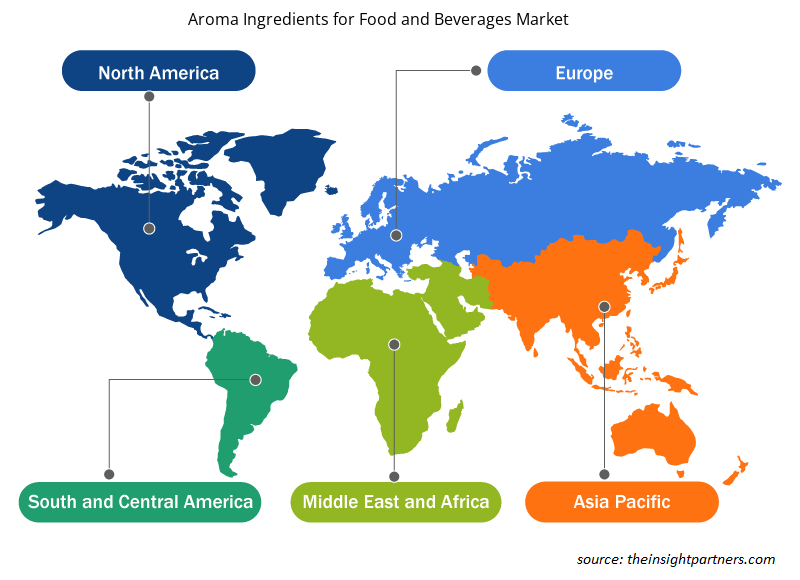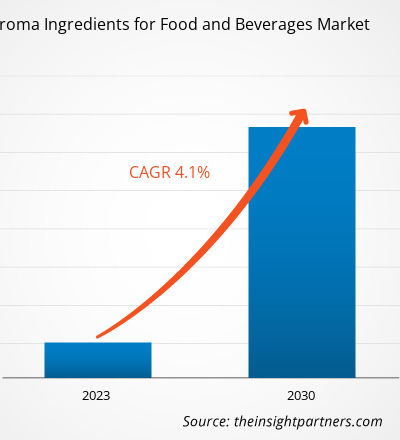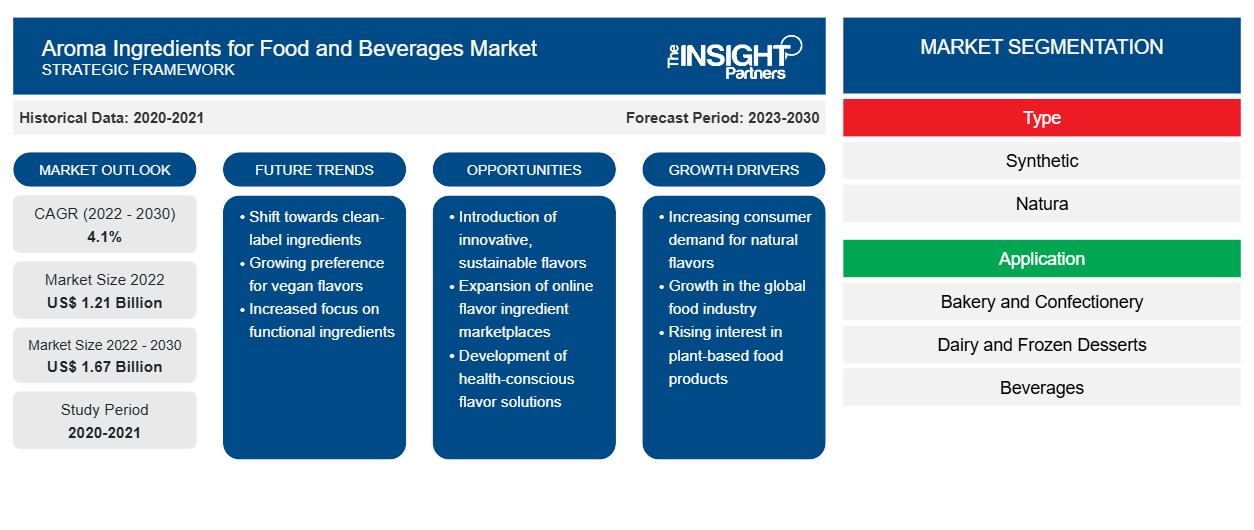[Forschungsbericht] Der Markt für Aromastoffe für Lebensmittel und Getränke soll von 1,21 Milliarden US-Dollar im Jahr 2022 auf 1,67 Milliarden US-Dollar im Jahr 2030 wachsen; der Markt dürfte von 2022 bis 2030 eine durchschnittliche jährliche Wachstumsrate (CAGR) von 4,1 % verzeichnen.
Markteinblicke und Analystenansichten:
Aromastoffe werden aus natürlichen Zutaten isoliert oder chemisch aus Erdöl extrahiert. Diese Zutaten spielen eine entscheidende Rolle bei der Gestaltung des Geschmacks- und Aromaprofils verschiedener Lebensmittel und Getränke, von Süßwaren und herzhaften Snacks bis hin zu alkoholischen und alkoholfreien Getränken. Die wachsende Bedeutung von Aromastoffen in der Lebensmittel- und Getränkeindustrie und strategische Initiativen wichtiger Marktteilnehmer sind wichtige Faktoren, die den Markt für Aromastoffe für Lebensmittel und Getränke antreiben. Darüber hinaus tragen die steigende Nachfrage der Verbraucher nach einzigartigen und exotischen Geschmacks- und Aromaerlebnissen sowie Fortschritte bei Extraktions- und Synthesetechniken weiter zur Gestaltung der Marktlandschaft bei. Die mit der Verwendung von Aromastoffen in der Lebensmittel- und Getränkeindustrie verbundenen regulatorischen Beschränkungen behindern jedoch das Wachstum des Marktes für Aromastoffe für Lebensmittel und Getränke .
Wachstumstreiber und Herausforderungen:
Hersteller von Aromastoffen in der Lebensmittel- und Getränkeindustrie sind stark an Fusionen und Übernahmen, Kooperationen und anderen strategischen Entwicklungen beteiligt, um Verbraucher anzuziehen und ihre Marktposition zu stärken. Die steigende Nachfrage nach Aromastoffen von verschiedenen Lebensmittel- und Getränkeunternehmen, die Back- und Süßwaren, Milchprodukte, gefrorene Desserts und andere Produkte herstellen und verkaufen, hat dazu geführt, dass wichtige Akteure strategische Initiativen ergreifen, um ihre Marktposition weltweit zu stärken. So kündigte BASF SE im November 2023 die Einführung von zwei neuen natürlichen Aromastoffen an: Isobionics Natural alpha-Bisabolene 98 und Isobionics Natural (-)-alpha-Bisabolol 99. Solche Produktentwicklungen treiben die Aromastoffe für den Lebensmittel- und Getränkemarkt voran.
Wichtige Marktteilnehmer erweitern ihre Produktionsanlagen und schließen Vereinbarungen mit Vertriebshändlern, um ihre Marktposition zu stärken. So kündigte Tilley Distribution, Inc. im Dezember 2021 die Fusion mit Phoenix Aromas and Essential Oils an. Die Fusion wird dazu beitragen, neue und bestehende Kundenstämme mit hochwertigen Produkten zu versorgen, und zwar mit Teams, die über Erfahrung in der Bereitstellung von regulatorischer und technischer Unterstützung verfügen. Darüber hinaus übernahm die Symrise AG im Juli 2021 die in Kanada ansässige Giraffe Foods Inc., einen kanadischen Hersteller von maßgeschneiderten Saucen, Dips, Dressings, Sirups und Getränkekonzentraten für B2B-Kunden. Die Übernahme wird das Segment Flavor & Nutrition von Symrise in Nordamerika erweitern und seine Marktposition und Kundenbasis stärken. Strategische Initiativen wichtiger Marktteilnehmer treiben also das Wachstum des globalen Marktes für Aromastoffe für Lebensmittel und Getränke voran.
Die Produktion und Verwendung von Aromastoffen in verschiedenen Lebensmittel- und Getränkeanwendungen wird von verschiedenen Regierungsbehörden reguliert. Regulierungsbehörden wie die Food and Drug Administration (FDA) und die Europäische Behörde für Lebensmittelsicherheit (EFSA) legen strenge Richtlinien und Standards für die Verwendung von Aromastoffen fest, um die Sicherheit der Verbraucher und die Produktqualität zu gewährleisten. Beispielsweise hat das Umweltprogramm der Vereinten Nationen die Verwendung von Lebensmittelaromen reguliert. Diese Verordnung sieht alle notwendigen Bedingungen für die korrekte, kontrollierte und sichere Verwendung von Geschmacksstoffen und aromatischen Zutaten oder Aromen in Lebensmitteln vor. Darüber hinaus hat die Food and Drug Administration (FDA) eine Verordnung über Lebensmittelaromen erlassen, die in und auf Lebensmitteln verwendet werden dürfen. Die Erfüllung dieser regulatorischen Anforderungen ist mit umfangreichen Test- und Dokumentationsprozessen verbunden, die für Hersteller zeitaufwändig und kostenintensiv sein können. Der Genehmigungsprozess für Aromastoffe kann langwierig und komplex sein, was Innovation und Produktentwicklung innerhalb der Branche weiter behindert.
Passen Sie diesen Bericht Ihren Anforderungen an
Sie erhalten kostenlos individuelle Anpassungen an jedem Bericht, einschließlich Teilen dieses Berichts oder einer Analyse auf Länderebene, eines Excel-Datenpakets sowie tolle Angebote und Rabatte für Start-ups und Universitäten.
- Holen Sie sich die wichtigsten Markttrends aus diesem Bericht.Dieses KOSTENLOSE Beispiel umfasst eine Datenanalyse von Markttrends bis hin zu Schätzungen und Prognosen.
Berichtssegmentierung und -umfang:
Die „Globale Marktanalyse für Aromazutaten für Lebensmittel und Getränke bis 2030“ ist eine spezialisierte und eingehende Studie mit einem Schwerpunkt auf Markttrends und Wachstumschancen. Der Bericht soll einen Überblick über den Markt mit detaillierter Marktsegmentierung nach Typ und Anwendung geben. Der Markt hat in der jüngsten Vergangenheit ein hohes Wachstum erlebt und wird diesen Trend im Prognosezeitraum voraussichtlich fortsetzen. Der Bericht liefert wichtige Statistiken zum weltweiten Verbrauch von Aromazutaten für Lebensmittel und Getränke. Darüber hinaus bietet der globale Marktbericht für Aromazutaten für Lebensmittel und Getränke eine qualitative Bewertung verschiedener Faktoren, die die Marktleistung weltweit beeinflussen. Der Bericht enthält auch eine umfassende Analyse der führenden Akteure auf dem Markt und ihrer wichtigsten strategischen Entwicklungen. Mehrere Analysen der Marktdynamik sind ebenfalls enthalten, um die wichtigsten Antriebsfaktoren, Markttrends und lukrativen Möglichkeiten zu identifizieren, die wiederum dazu beitragen würden, die wichtigsten Einnahmequellen zu identifizieren.
Die Prognose für den Markt für Aromastoffe für Lebensmittel und Getränke wird auf der Grundlage verschiedener sekundärer und primärer Forschungsergebnisse geschätzt, wie z. B. wichtiger Unternehmensveröffentlichungen, Verbandsdaten und Datenbanken. Darüber hinaus bieten die Ökosystemanalyse und Porters Fünf-Kräfte-Analyse eine 360-Grad-Ansicht des Marktes, die dabei hilft, die gesamte Lieferkette und verschiedene Faktoren zu verstehen, die die Marktleistung beeinflussen.
Segmentanalyse:
Die Aromastoffe für den Lebensmittel- und Getränkemarkt werden nach Art und Anwendung segmentiert. DurchTyp, der Markt ist in synthetisch und natürlich unterteilt. Das synthetische Segment ist weiter segmentiert in Terpene, Aldehyde, Aliphaten und andere. Das natürliche Segment ist weiter unterteilt in ätherische Öle , Kräuterextrakte, Oleoresine und andere. Im Jahr 2022 hatte das synthetische Segment den größten Marktanteil an Aromastoffen für Lebensmittel und Getränke. Das natürliche Segment wird voraussichtlich von 2022 bis 2030 die höchste CAGR verzeichnen. Synthetische Aromastoffe sind chemische Verbindungen, die natürliche Aromen in Lebensmitteln und Getränken nachahmen. Der Anstieg der Nachfrage nach diesen Zutaten in der Lebensmittel- und Getränkeindustrie kann auf mehrere Faktoren zurückgeführt werden. Erstens bieten synthetische Aromastoffe ein konsistentes Geschmacksprofil und stellen sicher, dass Produkte jedes Mal gleich schmecken, unabhängig von Variationen bei den natürlichen Zutaten. Diese Konsistenz ist entscheidend für die Markenidentität und die Verbraucherzufriedenheit. Zweitens sind sie im Vergleich zu natürlichen Aromastoffen kostengünstiger, was sie für Hersteller zugänglicher macht, insbesondere bei der Produktion im großen Maßstab. Darüber hinaus haben Fortschritte in der Geschmackswissenschaft zur Entwicklung synthetischer Zutaten geführt, die natürliche Aromen möglichst gut nachahmen, die Vorlieben der Verbraucher nach vertrauten Geschmäckern befriedigen und gleichzeitig einzigartige Geschmackskombinationen bieten. Abschließend lässt sich sagen, dass Bedenken hinsichtlich der Stabilität und Verfügbarkeit natürlicher Zutaten sowie regulatorischer Druck die Einführung synthetischer Aromastoffe in der Lebensmittel- und Getränkeindustrie weiter vorangetrieben haben.
Regionale Analyse:
Der Markt konzentriert sich auf fünf Schlüsselregionen – Nordamerika, Europa, Asien-Pazifik, Naher Osten und Afrika sowie Süd- und Mittelamerika. Der Asien-Pazifik-Raum hatte im Jahr 2022 mit einem Marktwert von ca. 425 Millionen US-Dollar den größten Marktanteil an Aromazutaten für Lebensmittel und Getränke.Der zweitgrößte Anteil entfiel auf Europa, gefolgt von Nordamerika.
In Europa ist die steigende Nachfrage nach Aromastoffen auf die reichhaltigen kulinarischen Traditionen der Region und die zunehmende Vorliebe für hochwertige und handwerklich hergestellte Produkte zurückzuführen. In ganz Europa herrscht eine starke kulturelle Wertschätzung für kulinarische Traditionen und Küche. Die Verbraucher in Europa legen Wert auf hochwertige Zutaten und authentische Aromen, was die Nachfrage nach Aromastoffen ankurbelt, die das Sinneserlebnis verbessern. Diese Betonung auf Gourmet-Exzellenz hat zu einem wachsenden Markt für hochwertige Aromastoffe aus natürlichen und nachhaltigen Quellen geführt, die den anspruchsvollen Geschmack der europäischen Verbraucher ansprechen. Darüber hinaus trägt das zunehmende Interesse an gesünderen und natürlicheren Lebensmitteloptionen in Europa zum Marktwachstum bei. Die europäischen Verbraucher haben sich für eine biologische und pflanzliche Ernährung entschieden, die oft Zutaten mit starkem oder ungewohntem Geschmack und Duft enthält, wie beispielsweise bestimmte Gemüsesorten, Getreide und Hülsenfrüchte. Um diese gesundheitsbewussten Entscheidungen attraktiver zu machen, verwenden Lebensmittelhersteller Aromastoffe, um aufdringliche oder unangenehme Aromen und Düfte abzumildern und sicherzustellen, dass die Produkte eine breite Akzeptanz bei den Verbrauchern behalten und gleichzeitig den Trends zu natürlichen und sauberen Etiketten entsprechen. Diese Nachfrage steht im Einklang mit der allgemeinen Qualität und dem Geschmack von Lebensmitteln in Europa sowie einem Bewusstsein für sensorische Erlebnisse, was alles dazu beiträgt, dass Aromastoffe für Lebensmittel und Getränke in der Region zunehmend eingesetzt werden.
In Nordamerika werden die Aromastoffe für den Lebensmittel- und Getränkemarkt auf steigende Umsätze bei Fertiggerichten und verpackten Lebensmitteln, die gut etablierte Lebensmittelindustrie und die wachsende Verbraucherpräferenz für funktionelle Getränke zurückgeführt. Aromastoffe spielen in diesen Produkten eine wichtige Rolle, da sie das Gesamtaroma der Produkte verbessern und sie für die Verbraucher attraktiver machen. Die wachsende Verbraucherpräferenz für natürliche und Clean-Label-Produkte hat zusätzlich zum Marktwachstum beigetragen. Da das Bewusstsein für Gesundheit und Wellness weiter steigt, suchen Verbraucher zunehmend nach Produkten mit natürlichen Aromastoffen. Dies hat Lebensmittel- und Getränkehersteller dazu veranlasst, Aromastoffe aus natürlichen Quellen wie Früchten, Kräutern und Gewürzen zu verwenden, um die Nachfrage der Verbraucher zu befriedigen. Darüber hinaus haben die Trends auf dem Markt für Aromastoffe für Lebensmittel und Getränke zur Premiumisierung im Lebensmittel- und Getränkesektor zur erhöhten Nachfrage beigetragen.
Aromastoffe für Lebensmittel und Getränke Marktregionale Einblicke
Die regionalen Trends und Faktoren, die den Markt für Aromastoffe für Lebensmittel und Getränke während des Prognosezeitraums beeinflussen, wurden von den Analysten von Insight Partners ausführlich erläutert. In diesem Abschnitt werden auch die Marktsegmente und die Geografie von Aromastoffen für Lebensmittel und Getränke in Nordamerika, Europa, im asiatisch-pazifischen Raum, im Nahen Osten und Afrika sowie in Süd- und Mittelamerika erörtert.

- Erhalten Sie regionale Daten zum Markt für Aromastoffe für Lebensmittel und Getränke
Umfang des Marktberichts über Aromastoffe für Lebensmittel und Getränke
| Berichtsattribut | Details |
|---|---|
| Marktgröße im Jahr 2022 | 1,21 Milliarden US-Dollar |
| Marktgröße bis 2030 | 1,67 Milliarden US-Dollar |
| Globale CAGR (2022 - 2030) | 4,1 % |
| Historische Daten | 2020-2021 |
| Prognosezeitraum | 2023–2030 |
| Abgedeckte Segmente | Nach Typ
|
| Abgedeckte Regionen und Länder | Nordamerika
|
| Marktführer und wichtige Unternehmensprofile |
|
Dichte der Marktteilnehmer für Aromastoffe für Lebensmittel und Getränke: Auswirkungen auf die Geschäftsdynamik verstehen
Der Markt für Aromastoffe für Lebensmittel und Getränke wächst rasant. Dies wird durch die steigende Nachfrage der Endverbraucher aufgrund von Faktoren wie sich entwickelnden Verbraucherpräferenzen, technologischen Fortschritten und einem größeren Bewusstsein für die Vorteile des Produkts vorangetrieben. Mit der steigenden Nachfrage erweitern Unternehmen ihr Angebot, entwickeln Innovationen, um die Bedürfnisse der Verbraucher zu erfüllen, und nutzen neue Trends, was das Marktwachstum weiter ankurbelt.
Die Marktteilnehmerdichte bezieht sich auf die Verteilung der Firmen oder Unternehmen, die in einem bestimmten Markt oder einer bestimmten Branche tätig sind. Sie gibt an, wie viele Wettbewerber (Marktteilnehmer) in einem bestimmten Marktraum im Verhältnis zu seiner Größe oder seinem gesamten Marktwert präsent sind.
Die wichtigsten Unternehmen auf dem Markt für Aromastoffe für Lebensmittel und Getränke sind:
- International Flavors & Fragrances Inc
- Sensient Technologies Corp
- T Hasegawa Co Ltd
- BASF SE
- V Mane Fils Sas
Haftungsausschluss : Die oben aufgeführten Unternehmen sind nicht in einer bestimmten Reihenfolge aufgeführt.

- Erhalten Sie einen Überblick über die wichtigsten Akteure auf dem Markt für Aromazutaten für Lebensmittel und Getränke
Branchenentwicklungen und zukünftige Chancen:
Laut Pressemitteilungen sind nachfolgend einige Initiativen wichtiger Akteure auf dem Markt für Aromastoffe für Lebensmittel und Getränke aufgeführt:
- Im März 2023 gab BASF SE seine Investition in eine neue Anlage in Zhanjiang, China, sowie in nachgelagerte Menthol- und Linalool-Anlagen in Ludwigshafen, Deutschland, bekannt. Diese Investition wird die Wertschöpfungskette der BASF für Aromastoffe in Deutschland und Malaysia erweitern und diversifizieren und die Wachstumsmöglichkeiten der Kunden unterstützen.
Wettbewerbslandschaft und Schlüsselunternehmen:
International Flavors & Fragrances Inc, Sensient Technologies Corp, T Hasegawa Co Ltd, BASF SE, V Mane Fils Sas, Symrise AG, Firmenich International SA, Archer-Daniels-Midland Co, Kerry Group Plc und Berje Inc gehören zu den wichtigsten Akteuren, die im Marktbericht über Aromastoffe für Lebensmittel und Getränke vorgestellt werden. Die globalen Marktteilnehmer konzentrieren sich darauf, qualitativ hochwertige Produkte anzubieten, um die Kundennachfrage zu erfüllen.
- Historische Analyse (2 Jahre), Basisjahr, Prognose (7 Jahre) mit CAGR
- PEST- und SWOT-Analyse
- Marktgröße Wert/Volumen – Global, Regional, Land
- Branchen- und Wettbewerbslandschaft
- Excel-Datensatz
Aktuelle Berichte
Verwandte Berichte
Erfahrungsberichte
Grund zum Kauf
- Fundierte Entscheidungsfindung
- Marktdynamik verstehen
- Wettbewerbsanalyse
- Kundeneinblicke
- Marktprognosen
- Risikominimierung
- Strategische Planung
- Investitionsbegründung
- Identifizierung neuer Märkte
- Verbesserung von Marketingstrategien
- Steigerung der Betriebseffizienz
- Anpassung an regulatorische Trends























 Kostenlose Probe anfordern für - Aromastoffe für den Lebensmittel- und Getränkemarkt
Kostenlose Probe anfordern für - Aromastoffe für den Lebensmittel- und Getränkemarkt